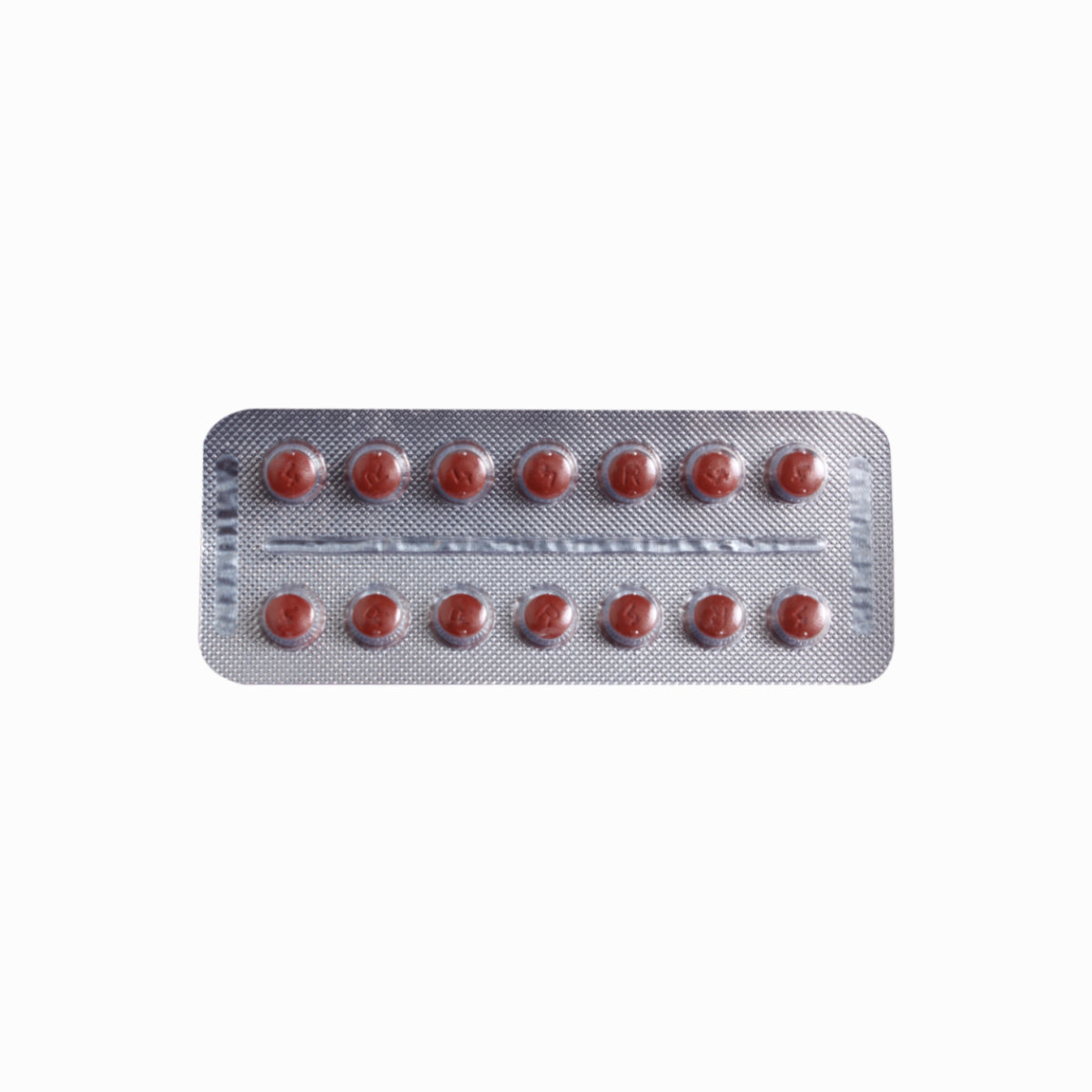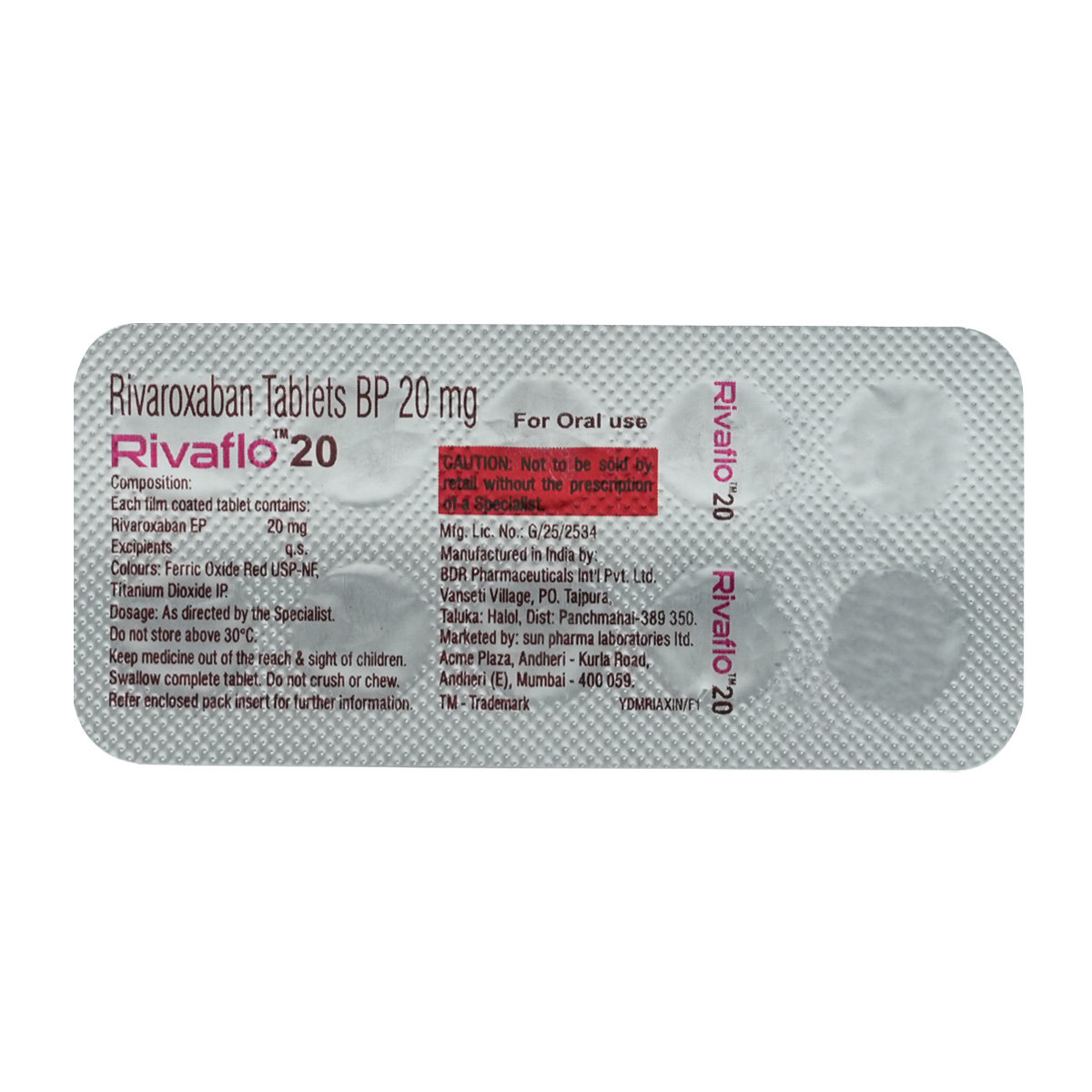Rivarox 20 Tablet 10's


MRP ₹328
(Inclusive of all Taxes)
₹49.2 Cashback (15%)
Provide Delivery Location
Online payment accepted
 Prescription drug
Prescription drugWhats That
Composition :
Manufacturer/Marketer :
Consume Type :
Expires on or after :
Return Policy :
About Rivarox 20 Tablet
Rivarox 20 Tablet belongs to a class of drugs known as anticoagulants or blood thinner. Rivarox 20 Tablet is primarily used to prevent and treat deep vein thrombosis (blood clots in leg veins) and pulmonary embolism (blood clots in the lung) by reducing blood clot formation. Deep vein thrombosis is a medical condition in which blood clots form in deep veins usually in the legs. Pulmonary embolism is a condition in which a blood clot blocks the arteries in the lungs.
Rivarox 20 Tablet contains Rivaroxaban, a blood thinner that works by inhibiting the production of clotting factors by decreasing the action of vitamin K. This prevents the conversion of fibrinogen (soluble protein) to fibrin (insoluble protein), thereby preventing blood clots formation.
Take Rivarox 20 Tablet as prescribed. You are advised to take Rivarox 20 Tablet for as long as your doctor has prescribed it for you depending on your medical conditions. You may experience bleeding, anemia (low number of red blood cells), and nausea. Most of these side effects of Rivarox 20 Tablet do not require medical attention and gradually resolve over time. However, if the side effects are persistent, reach out to your doctor.
If you are known to be allergic to Rivarox 20 Tablet or any other medicines, please tell your doctor. If you are pregnant or breastfeeding, it is advised to consult a doctor before using Rivarox 20 Tablet . If you have a stomach ulcer, kidney or liver problems, high blood pressure, or bleeding problems, inform your doctor before taking Rivarox 20 Tablet . Talk to your doctor immediately if you are pregnant or breastfeeding.
Uses of Rivarox 20 Tablet
Directions for Use
Key Benefits
Rivarox 20 Tablet belongs to a class of drugs known as anticoagulants or blood thinner. Rivarox 20 Tablet is primarily used to prevent and treat deep vein thrombosis (blood clots in leg veins) and pulmonary embolism (blood clots in the lung) by reducing blood clot formation. Rivarox 20 Tablet works by inhibiting the production of clotting factors by decreasing the action of vitamin K. This prevents the conversion of fibrinogen (soluble protein) to fibrin (insoluble protein), thereby preventing blood clots formation.
Storage
Drug Warnings
Rivarox 20 Tablet should be used with caution in children. Prolonged use of Rivarox 20 Tablet may cause hair loss. Regular blood tests are recommended while taking Rivarox 20 Tablet to check the time taken for your blood to clot and the level of platelets (blood cells). If you are known to be allergic to Rivarox 20 Tablet or any other medicines, please tell your doctor. If you are pregnant or breastfeeding, it is advised to consult a doctor before using Rivarox 20 Tablet . If you have a stomach ulcer, kidney or liver problems, high blood pressure, or bleeding problems, inform your doctor before taking Rivarox 20 Tablet . Talk to your doctor immediately if you are pregnant or breastfeeding.
Diet & Lifestyle Advise
- Avoid making any changes in your diet without first talking to your doctor.
- Cranberry juice, grapefruit juice, noni juice, and pomegranate juice may interact with Rivarox 20 Tablet and lead to unwanted side effects. Hence try to avoid these juices while taking Rivarox 20 Tablet .
- Avoid drinking alcohol as it increases the risk of gastrointestinal ulcer/bleeding.
Side Effects of Rivarox 20 Tablet
- Bleeding
- Anaemia (low number of red blood cells)
- Nausea
Habit Forming
Therapeutic Class
All Substitutes & Brand Comparisons
RX
Xarex 20 Tablet 15's
Alteus Biogenics Pvt Ltd
₹181.5
(₹10.89 per unit)
63% CHEAPERRX
Rpigat 20 mg Tablet 10's
Natco Pharma Ltd
₹131
(₹11.79 per unit)
60% CHEAPERRX
Rivaban 20 Tablet 10's
Lupin Ltd
₹203.5
(₹18.32 per unit)
37% CHEAPER
Product Substitutes
FAQs
No, you are not recommended to stop taking Rivarox 20 Tablet without consulting your doctor to worsen the condition. Therefore, take Rivarox 20 Tablet for as long as your doctor has prescribed it.
No, Rivarox 20 Tablet is not expected to cause weight gain. If you notice unexpected weight gain and think it is because of this Rivarox 20 Tablet , immediately consult your doctor and inform him about it.
Rivarox 20 Tablet has many beneficial effects, but it has the ability to make you bleed more than normal. Even with minor injuries as it decreases your ability to blood clotting. Sometimes Rivarox 20 Tablet may cause severe bleeding that may be dangerous and may require urgent medical care. This risk may be increased in people taking Rivarox 20 Tablet along with other blood thinner medicines.
Avoid taking grapefruit and grapefruit juice while taking Rivarox 20 Tablet , and it contains compounds that slow down the metabolism of Rivarox 20 Tablet and increase the activity leading to bleeding.
It is not known that Rivarox 20 Tablet causes hair loss. Kindly contact your doctor.
Rivarox 20 Tablet is a type of medicine known as an anticoagulant. Rivarox 20 Tablet works by stopping a clotting factor called factor Xa from working. This thins your blood, so it takes longer to clot.
Drug-Drug Interactions Checker List
- WARFARIN
- ENOXAPARIN
- LOPINAVIR
- RITONAVIR
- ASPIRIN
- IBUPROFEN
- CARBAMAZEPINE
- PHENYTOIN
- ITRACONAZOLE
- KETOCONAZOLE
- FLUCONAZOLE
- ERYTHROMYCIN
- CLARITHROMYCIN
Special Advise
You should have regular platelet count, factor V assay, fibrinogen level test, prothrombin time test (PT or PT-INR) and the INR, or international normalized ratio to analyze your blood clotting time.
Disease/Condition Glossary
Deep vein thrombosis (blood clots in legs) is a medical condition in which blood clots form in deep veins usually in the legs. The symptoms include leg pain or swelling. Pulmonary embolism (blood clots in the lung) is a chronic condition that occurs as the blood clots break and travel to the lungs from deep veins in the legs or other parts of the body. The symptoms of pulmonary embolism include cough, chest pain, and shortness of breath.

Have a query?
Alcohol
Safe if prescribed
You are recommended to avoid consumption of alcohol with Rivarox 20 Tablet as it may increase the risk of bleeding.
Pregnancy
Consult your doctor
Tell your doctor before using Rivarox 20 Tablet because it may cause harmful effects. So, only use in that condition when a doctor is prescribed.
Breast Feeding
Consult your doctor
Rivarox 20 Tablet may pass into breast milk. Therefore consult your doctor.
Driving
Safe if prescribed
Rivarox 20 Tablet usually does not affect your ability to drive or operate machinery.
Liver
Consult your doctor
Take Rivarox 20 Tablet with caution, especially if you have a history of Liver diseases/conditions. The dose may be adjusted by your doctor as required.
Kidney
Consult your doctor
Take Rivarox 20 Tablet with caution, especially if you have a history of Kidney diseases/conditions. The dose may be adjusted by your doctor as required.
Children
Safe if prescribed
Rivarox 20 Tablet is not approved for children. Therefore Rivarox 20 Tablet is not safe for children.
















